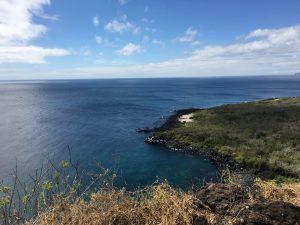
Kiran (my son) and I got to visit the Galápagos Islands – a fascinating archipelago admired for its unique collection of species and its exclusive ecosystem. Darwin’s exceptional work in “Origin of Species … ” started with endemic (unique to one location) nature of species he found in each of these islands.I found another fascinating thing about its simple ecosystem, no major predators (wild cats, wolfs, bears, snakes, etc.) and a friendly collection of animals and birds that you can almost touch – I will write on this later. Whether you are evolutionist agreeing with competitive selection, or a creationist believing solely in creation or someone in between in your belief, these islands provide for you plenty to wonder and ponder about. Darwin’s lifetime was surely not enough to describe all that he had observed during his 5 weeks in The Beagle. Darwin’s journey began in the island of “San Cristobal”, where Kiran and I got to travel as part of an environmental conservation trip with Projects Abroad.
Flying through Panama City, Panama and then Quito, Ecuador gave us plenty of time to brush up on some basic Spanish and also to get ready for a simpler life in South America. Our Sunday was generally relaxed as we explored the Cerro Tijereta, diving into clean water to find plenty of fish – colorful triggerfish, clown fish, grunts, wrasse and more. Soon our week of volunteer work started, when we were expected to stay busy with the following:
- Study the Seal population in the three busy beaches of San Cristobal
- Harvest and feed Otoy or Xanthosoma plants to the Galapagos giant tortoises
- Clean up the invasive plant species at Galapagera reserve
- Survey the threatened Galapagos Petrel’s nest & reduce rat population
- Observe La Lobería seabird population and nesting grounds
- Clean up the trash in the ocean
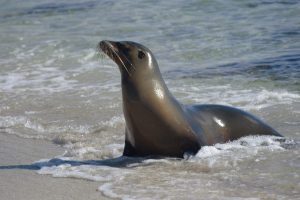
The seals were skillful in the water, playing and fishing with great agility and speed. They were also asleep a lot as we surveyed their behavior in the beaches. We found from survey there are about 12:1 ratio of adult females to alpha male seals. The seals were usually healthy with few rare eye infections and some weaker juveniles. The young pups were a delight to watch. The juveniles absolutely ready to play with anyone in the water showing off their diving skills and revealing their love for communication (vocal and touch!).
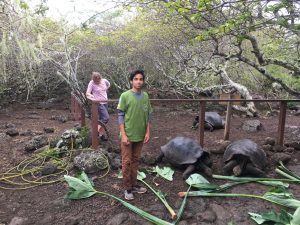
Harvesting Otoy to collect about 150 Kg of it in trucks and get it to the Galapegera tortoise reserve seemed like enough work, but we also got to clear the land from invasive plants so the tortoises could roam freely. The tortoises surely enjoyed Otoy plants and their ability to roam about this reserve. The baby tortoises from 2 months to 2 years old were adorable tiny dinosaurs finding their way in little cages while being fed freshly chopped Otoy salad.
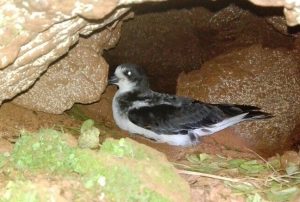
The Galapagos Petrel is endemic to the Galapagos archipelago, where it nests in five main islands including San Cristobal, otherwise these birds are true to their pelagic nature out far from the beaches in the ocean. The species is considered ‘Critically Endangered’, mostly due to the effects of invasive species (like rats and mice), which impair its reproduction. This trip to their nesting area was an invitation to get completely into muddy humid highlands and peer into their private lives. The rain from the night before made it plenty muddy and highly humid for us to traverse. We got to visit a number of petrel nests intruding into these recluse bird nesting area while trying to pack rat poison into little tubes for the invasive mammals to be kept under control.
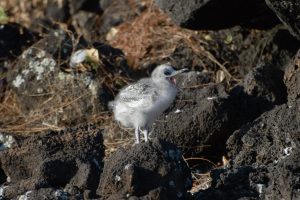
La Lobería was a delightful place with its deep crevices of rocks right next to the ocean allowing great frigate birds, swallow-tailed gull and tropic bird to roost just like on perches and glide using the high winds from the ocean. The birds smoothly hang on to the wind and watch the people on the ground while also scanning the sea turtles underwater with great ease and beauty. We even found a swallow-tailed gull chick yawning while getting a peek of sun and exploring the world around before it will be ready to fly.
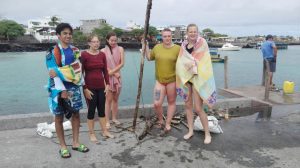
The next morning “activity” was to get into cold waters (about 55F or 12C) to clean up the trash being washed into the rocks. The swim from Pier-II point into Playa Mann beach was not for everyone to be able to accomplish. A bunch of cleanup work included removal of an old pipe, a large piece of rag cloth, a metal board, a soup can, bottles, ropes and plenty of junk washed over. I still thought it was surprisingly clean compared to Virginia Beach where I’ve seen whole leather briefcase underwater. This was also an opportunity to catchup in seeing plenty of colorful fish, octopus and a friendly seal which almost knocked Kiran around while playing with him.
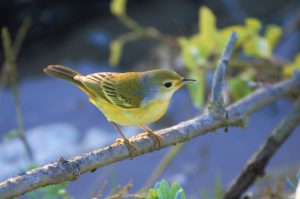
Many of the stops and few of the pauses in our trip, I got to reflect on Darwin’s fascination with this per-island endemic species and his resolve to explain it via the natural selection – focusing a bit more on the competitive selection. But I also got to ponder on another fact – a very simple ecosystem I noticed in which almost every creature had less fear of predators and definitely less fear of humans. This particular yellow warbler for example would have been willing to be hand-fed if I were able to settle and wait (which I myself have not really been good at).
From my childhood, I have wondered if we can co-exist in such a friendly way with animals and nature learning to share our world. The idea did remind me of the “Wolf and the Lamb” account in Isaiah 11 as Isaiah reflected a period where there will be no need competition for survival but a promise “not harm or destroy” as we dwell together- Isaiah 11:9. As much as evolution seems now to have explained the past in a way that humans would like set aside God, what if need God more for the future? Especially to find a place where we can dwell together in peace (free from evil and free from sin)- humans with each other and animals along with the rest of the nature together without a need to “harm or to destroy”!
